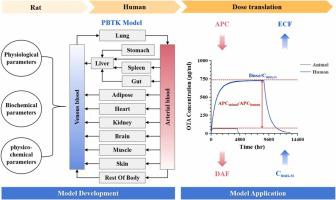当前位置:
X-MOL 学术
›
Ecotox. Environ. Saf.
›
论文详情
Our official English website, www.x-mol.net, welcomes your feedback! (Note: you will need to create a separate account there.)
Development and application of the physiologically-based toxicokinetic (PBTK) model for ochratoxin A (OTA) in rats and humans
Ecotoxicology and Environmental Safety ( IF 6.8 ) Pub Date : 2024-04-10 , DOI: 10.1016/j.ecoenv.2024.116277 Bu-Da Su , Xiao-Meng Li , Zhi-Wei Huang , Yue Wang , Jia Shao , Yan-Yan Xu , Le-Xin Shu , Yu-Bo Li
Ecotoxicology and Environmental Safety ( IF 6.8 ) Pub Date : 2024-04-10 , DOI: 10.1016/j.ecoenv.2024.116277 Bu-Da Su , Xiao-Meng Li , Zhi-Wei Huang , Yue Wang , Jia Shao , Yan-Yan Xu , Le-Xin Shu , Yu-Bo Li

|
Ochratoxin A (OTA) is a common fungal toxin frequently detected in food and human plasma samples. Currently, the physiologically based toxicokinetic (PBTK) model plays an active role in dose translation and can improve and enhance the risk assessment of toxins. In this study, the PBTK model of OTA in rats and humans was established based on knowledge of OTA-specific absorption, distribution, metabolism, and excretion (ADME) in order to better explain the disposition of OTA in humans and the discrepancies with other species. The models were calibrated and optimized using the available kinetic and toxicokinetic (TK) data, and independent test datasets were used for model evaluation. Subsequently, sensitivity analyses and population simulations were performed to characterize the extent to which variations in physiological and specific chemical parameters affected the model output. Finally, the constructed models were used for dose extrapolation of OTA, including the rat-to-human dose adjustment factor (DAF) and the human exposure conversion factor (ECF). The results showed that the unbound fraction (F) of OTA in plasma of rat and human was 0.02–0.04% and 0.13–4.21%, respectively. experiments, the maximum enzyme velocity (V) and Michaelis–Menten constant (K) of OTA in rat and human liver microsomes were 3.86 and 78.17 μg/g min, 0.46 and 4.108 μg/mL, respectively. The predicted results of the model were in good agreement with the observed data, and the models in rats and humans were verified. The PBTK model derived a DAF of 0.1081 between rats and humans, whereas the ECF was 2.03. The established PBTK model can be used to estimate short- or long-term OTA exposure levels in rats and humans, with the capacity for dose translation of OTA to provide the underlying data for risk assessment of OTA.
中文翻译:

大鼠和人类赭曲霉毒素 A (OTA) 生理学毒代动力学 (PBTK) 模型的开发和应用
赭曲霉毒素 A (OTA) 是一种常见的真菌毒素,经常在食品和人体血浆样本中检测到。目前,基于生理学的毒代动力学(PBTK)模型在剂量转换中发挥着积极作用,可以改善和增强毒素的风险评估。本研究基于OTA特异性吸收、分布、代谢和排泄(ADME)知识,建立了大鼠和人类OTA的PBTK模型,以更好地解释OTA在人类体内的分布以及与其他物种的差异。 。使用可用的动力学和毒代动力学(TK)数据对模型进行校准和优化,并使用独立的测试数据集进行模型评估。随后,进行敏感性分析和群体模拟,以表征生理和特定化学参数的变化影响模型输出的程度。最后,构建的模型用于OTA的剂量外推,包括大鼠-人体剂量调整因子(DAF)和人体暴露转换因子(ECF)。结果显示,大鼠和人血浆中OTA的未结合分数(F)分别为0.02-0.04%和0.13-4.21%。实验显示,大鼠和人肝微粒体中OTA的最大酶速度(V)和米氏常数(K)分别为3.86和78.17 μg/g·min、0.46和4.108 μg/mL。模型的预测结果与观测数据吻合良好,模型在大鼠和人体中得到了验证。 PBTK 模型得出大鼠和人类之间的 DAF 为 0.1081,而 ECF 为 2.03。建立的PBTK模型可用于估计大鼠和人类短期或长期OTA暴露水平,并具有OTA剂量翻译能力,为OTA风险评估提供基础数据。
更新日期:2024-04-10
中文翻译:

大鼠和人类赭曲霉毒素 A (OTA) 生理学毒代动力学 (PBTK) 模型的开发和应用
赭曲霉毒素 A (OTA) 是一种常见的真菌毒素,经常在食品和人体血浆样本中检测到。目前,基于生理学的毒代动力学(PBTK)模型在剂量转换中发挥着积极作用,可以改善和增强毒素的风险评估。本研究基于OTA特异性吸收、分布、代谢和排泄(ADME)知识,建立了大鼠和人类OTA的PBTK模型,以更好地解释OTA在人类体内的分布以及与其他物种的差异。 。使用可用的动力学和毒代动力学(TK)数据对模型进行校准和优化,并使用独立的测试数据集进行模型评估。随后,进行敏感性分析和群体模拟,以表征生理和特定化学参数的变化影响模型输出的程度。最后,构建的模型用于OTA的剂量外推,包括大鼠-人体剂量调整因子(DAF)和人体暴露转换因子(ECF)。结果显示,大鼠和人血浆中OTA的未结合分数(F)分别为0.02-0.04%和0.13-4.21%。实验显示,大鼠和人肝微粒体中OTA的最大酶速度(V)和米氏常数(K)分别为3.86和78.17 μg/g·min、0.46和4.108 μg/mL。模型的预测结果与观测数据吻合良好,模型在大鼠和人体中得到了验证。 PBTK 模型得出大鼠和人类之间的 DAF 为 0.1081,而 ECF 为 2.03。建立的PBTK模型可用于估计大鼠和人类短期或长期OTA暴露水平,并具有OTA剂量翻译能力,为OTA风险评估提供基础数据。



























 京公网安备 11010802027423号
京公网安备 11010802027423号